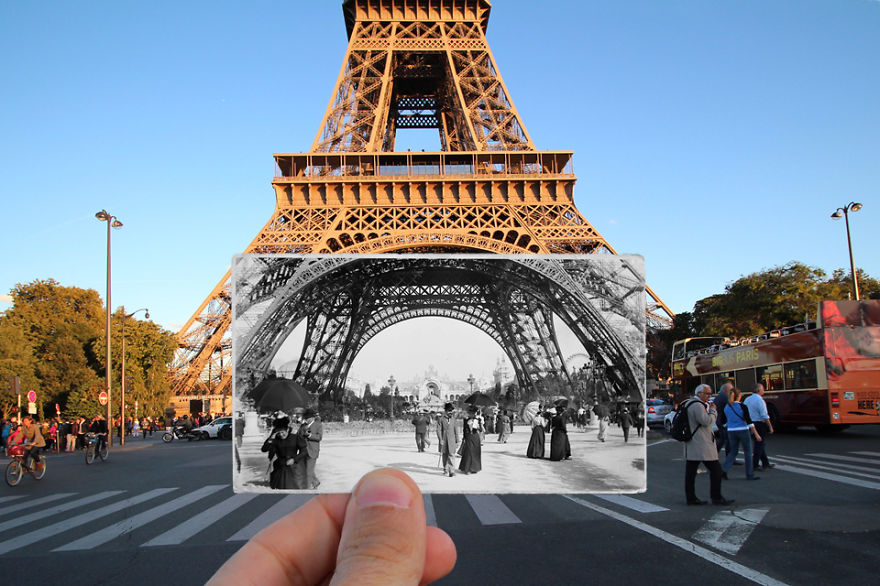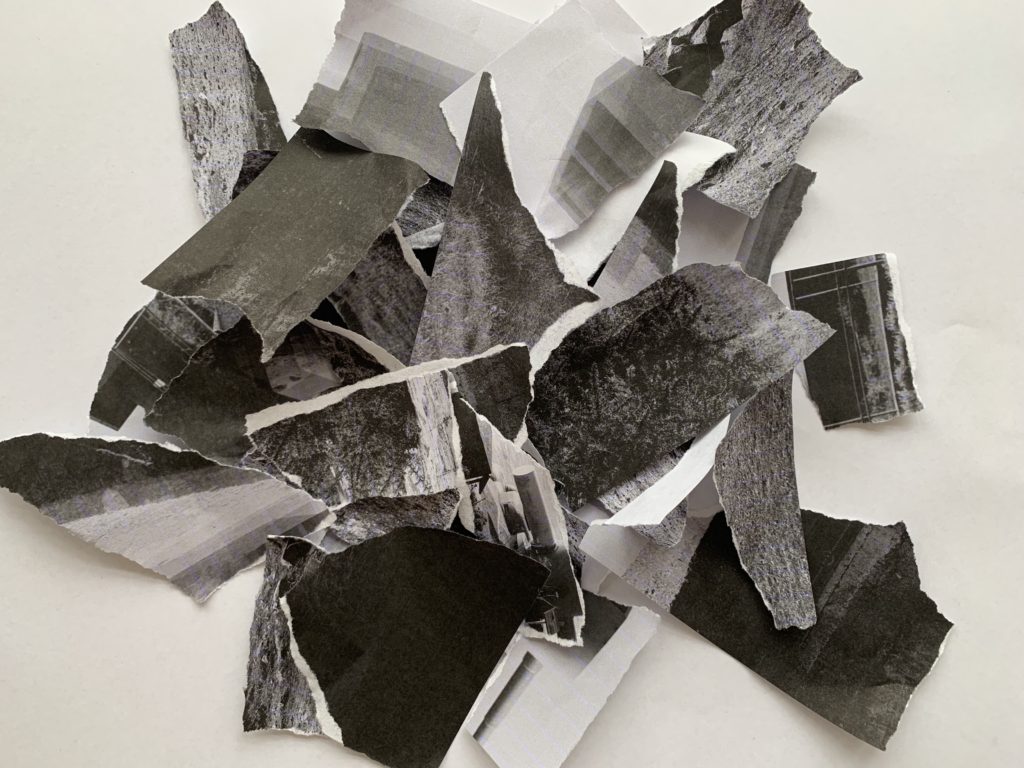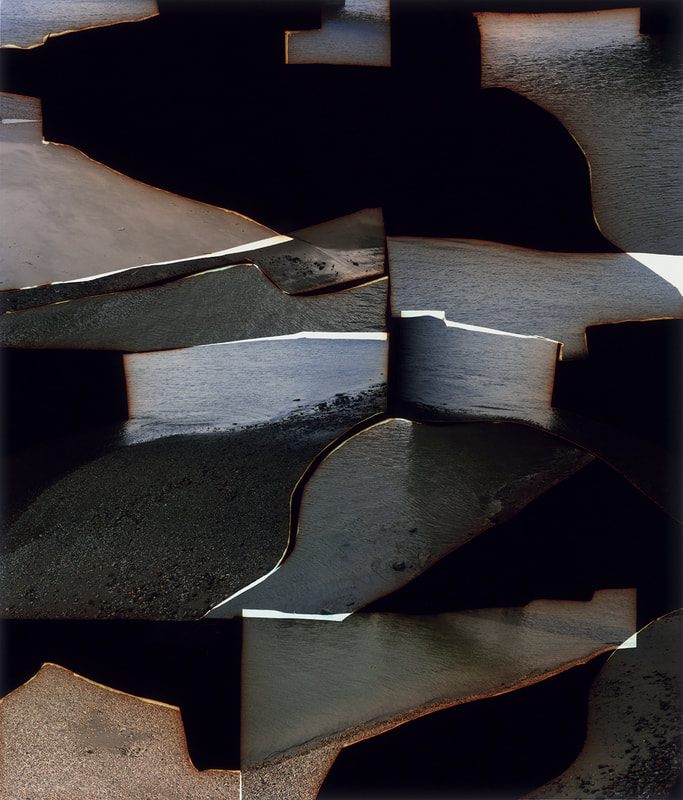Knez Replication:
As previously researched Knez wanted to showcase the historical factors by using old vintage photographs of landmarks and holding the vintage image up to the landmark, in the exact same location but many years down the line, which presents the journey of the landmark. To implement this into my work I decided to use my successful images and showcase how the subject has changed overtime, showcasing the Journey of Jersey after the war and how these places have developed. I started off by making exact replications of Knez’s work. To do so I opened up the image I wanted to use twice, on one of the page I converted the image black and white (ctrl + u). I then placed the black and white image on top of the colour version of the same image. Using the rectangular marquee tool I selected an area I wanted to be black and white and selected layer via cut. I then deleted the black and white layer leaving me with the square in black and white and the original coloured image. The first image is the most successful as you are able to see the difference in the two colours and presents the same conceptual factors of Knez.

Comparison:

My Photograph 
Knez’s Photograph
To compare my work to Knez’s work there are many similarities, the main one being I used the same method and ideology, to create my outcome, as Knez. We both used black and white images in the same location/angle of the coloured image to showcase how the landmark has changed. Due to this we both have presented the formal elements of space, tone, texture through the technique use. One main difference is that I produced my image using photoshop, making it seem more artificial, where as Knez actually used an old photograph and took it to the location, which make a more realistic image showcasing his excellent photographic skills. We both have used natural lighting to capture our subjects, which is mainly because the subjects are located outdoors, which again makes the image more naturalistic. We both went around the idea using the same artistic aim, however I wanted to showcase Jersey Journey after the second world war and Knez showcased how landmarks in Paris has changed, which presents a slight difference. Another major difference is that the subject being captured is completely different, which is due to the different conceptual factors we wanted to showcase. Similarly, both images use good camera skills: We both used a wide depth of field, quick shutter speed, low ISO and normal aperture. Using similar camera settings has allowed my replication to be more successful and showcase my ability to clearly and accurately replicate work. To conclude, I believe my image is very much like the artists, but still has my own artistic style within it, which makes it successful and one of my favourite outcomes produced.
Talmor Replication:
The image below is my attempt at creating Talmor’s work. I used three of my top bunker images to achieve this look. I printed all three in black and white on A4 paper. Once printed I then ripped them up and started randomly placing the sections in different locations on a piece of white A3 paper, ensuring they overlap. This simplistic craft idea distorts the viewers and makes them question what is being showcased. When they realise it is Jersey’s bunkers they then question why it is like the way it is, which allows the aim of Talmor to be presented, take away emotion, connection and connotations aways from building to make us think more subjectively about them. This allows us to understand that the bunkers had a massive impact in the journey of Jersey in the second world war, but showcases how we should remember what happened but not hold as much connection emphasising the Journey of Jersey. This powerful message is successfully conveyed in my work.


Images used 
To replicate 
Talmor’s work
Other Experimentations:



Comparison:

Talmor’s Work 
My Work
The main similarity shared between both images is the technique used to create the photograph, we both tarred our images and randomly layered them on top of each other to create an overall abstract looking image. Another similarity, is that we both used the same artistic aim which was to detach viewers from any emotional/memories to the specific location. Contextually, we both have different contextual factors as to why we created them, Talmor’s was her own memories, where as mine is more general as it is the viewers memories of the war and the importance of Jersey’s bunkers during the second world war. Needless to say the subject in both images are different because of the different contextual factors. Another difference is that my image is in black and white where as Talmor’s is in colour, which makes my image have more tonal contrast making it more abstract and creates a more distorted look. My image is much more busier than Talmor’s as I have more tarred up bits and used three different images where as Talmor only used one image, which means the meaning of my image is more disguised and harder to work out. In addition, Talmor’s montage takes up the whole frame where as mine only takes up the centre, as it would have been too chaotic to take up the whole of the frame. Moreover, Talmor seems to have burnt the segments to distort and empty out connections , which showcases her emotion more within the image, where as I only tore my image into segments Similarly, both images have used similar camera settings such as natural lighting, quick shutter speed, low ISO and wide depth of field, making the actual segments very similar. Both images are successful in what they do, as you can see I understood the requirements to recreate Talmor’s work and implemented it into my response and still managed to add my own artistic style to it.
Craft Ideas:
After the high success of the image manipulation in the style of Knez and Talmor I decided to further explore there nature but in my own artistic style to showcase the Journey of Jersey through WW2

In this first Idea I printed out an image of a bunker, once in colour and once in black and white. I simply teared up the black and white image and carefully stuck it down to the coloured image to showcase the bunker’s journey after the second world war, which presents the ideology that nothing has changed as they have been left alone. I really like the way this edit has turned out as it showcases the same conceptual and contextual factors as the edit of the replication of Knez’s work, which outlines how this edit can be successful. It also clearly shows my ability to use other methods to manipulate my image and showcases further exploration into this project.

For my final edit I wanted to showcase how propaganda now a days means nothing and how we understand how it manipulated people back during the war, outlining the Journey of Jersey through/after the second world war. To achieve this I printed out the above, I then. cut out the head region in a square and screwed it up into a ball. I then unravelled the ball and took a picture of the creased paper. Then using photoshop I opened up the original image of the propaganda and the picture of the creased face. Using the quick selection tool I cut out the face and placed it onto the original image. Using ctrl + t, I adjusted it so it was the face was the right size and fit perfectly on my model. Finally I added a drop shadow to the creased face layer to make it stand out. I really like the way this edit has turned out as it changes the way we view the propaganda and allows us to realise how the poster has almost decayed as it’s lost meaning, as we begun to realise what propaganda was doing to us.
Evaluation:
To evaluate these edits I believe that I have produced some successful outcomes which showcases further exploration into the Journey of Jersey through the second world war. These edits begin to look at what Jersey is like after the war, presenting the Journey of Jersey after the war, but still have strong links to the original title of the project. I have been able to successfully replicate another artists work by using photoshop. I have also been able to showcase my ability to use hand crafts to manipulate my images, and shows my ability to use artists work to inspire mine. I have thoughtfully made decisions about how I will edit and manipulate my images to produce strong conceptual factor, which link to the contextual factors. Moreover, I was successfully able to replicate Talmor’s work and implement it into my theme, in order to showcase the ideology that people are trying to loose attachment from Jersey’s bunkers due to their role and impact during the Journey of Jersey through the second world war. It has allowed me to think differently about different ways of displaying images and has allowed my crafts skills to clearly be utilised and shown. The images produced are very successful and will be considered to be used as final images, in order to display my best work which showcases the Journey of Jersey through WW2.





